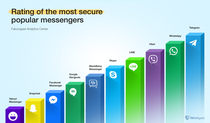

How to Prevent Backdoor-Viruses' Attacks
Backdoor is a method that allows anyone, whether it is an ordinary user or an attacker, to bypass authentication on the device and gain access to data. Hackers can install a backdoor on the device by sending a file with a malicious program, using a vulnerability in the system, or even manually, if, for example, the company has an insider that is interested in the theft of data. In fact, the backdoor is a new remote entry point into the device for non-authorized users. Backdoors are mainly used by attackers to access databases or file servers.
Backdoors are often installed along with vulnerable applications that hackers are looking for in advance and contain a malicious program there that was previously disguised so that it is impossible to detect it on the device. Access to the system through a backdoor is the necessary attribute of attacks on confidential data because scammers have the opportunity not only to observe user actions, and reading activity, but also to intercept information in real-time, as well as establish other malicious software for new attacks.
It is important to note that a backdoor is not a specific program that gives remote access to the computer, but any program through which you can access. Backdoors can be keyloggers, trojans, utilities, applications, crypto programs, etc.
Types of backdoors
As we have already noted, in order to start using someone else's system remotely, attackers first need to install a backdoor program on a computer physically or using phishing or social engineering. They can easily get to the system through outdated software, weak passwords and firewalls, and systems with single-factor authentication. Below we give the most popular backdoors:
Trojans - programs that pretend to be legitimate to gain access to the device. After the user presses “I allow changes in the system”, the Trojan is self-installs and opens access to all files and even sets new malicious programs. Often, a special code is also set along with Trojan, which will restore access, even if the vulnerability of the system is eliminated.
Rootkits - sets of programs performing specially set functions, for example, disguising objects, managing events in the system, data collection. Rootkits act as advanced backdoors, as they can completely disguise their presence in the system. Rootkits give hackers remote access and allow you to easily sabotage data. Such a programmable set can be in the form of an application or even in the form of a physical computer chip, which the victim manually sets in the computer.
Physical backdoors are modified computer chips containing a remote access program. Physical backdoors can be smartphones, any devices of the Internet of things, thermostats, routers, computers, technological solutions of the Smart House, etc. Physical backdoors are transferred live and can be delivered to a company, which they want to sabotage, sent as a gift, or delivered from the allegedly known sender. There is only one goal - to force the user to turn on the device or program by launching the attack process.
Cryptographic backdoors are codes that can decipher encrypted information using a special encryption protocol. For example, if users communicate through a messenger that uses the principle of encryption, the information transmitted between people is encrypted from both ends and is not known to third parties, it is possible to establish a cryptographic backdoor only from the inside, sending it in the chat. After loading, the code will begin to decrypt the data from the chat and drain it to the attackers.
Further actions
After installing a backdoor on a computer and receiving remote access, hackers can simply observe and quietly collect information, but can continue to implement and attack other malicious software for extortion; make attacks such as DDoS; implement spy software, which will collect the personal data of the user, such as data from card and accounts; use crypto-jacking and take possession of the user online or crypto-wallet.
How to prevent backdoor attacks?
1. Use multi-factor authentication and strong passwords. Unfortunately, the data leak due to insufficient reliability of the password is one of the most common causes of hacking in 2022. Multifactor authentication, in addition to the password, includes confirmation of the individual in another way, for example, using biometrics or a disposable SMS code.
2. Do not delay the update of applications. As the applications are obsolete, there are more and more vulnerabilities through which the attacker can establish backdoors. According to statistics, each third leak occurs due to the untimely update of the applications, where the vulnerability has already been eliminated. The developers regularly publish applications updates, so do not neglect them and update immediately, as a notification of updating comes.
3. Install the DLP system. DLP system is a software solution necessary for companies that do not want to lose their confidential data. DLP SecureTower from Falcongaze is a functional system that controls all user communication channels. Where can we “catch” malicious programs? When visiting different Internet resources. And backdoors can also lurk in phishing and spam messages, which are very often transmitted by email, through instant messengers and social networks, and cloud storages.
SecureTower controls the entire mail transmitted through the protocols MAPI, POP3, SMTP, IMAP, HTTP + mail of external postal services, such as Gmail, Mail.ru, Yandex.Mail. The system automatically analyzes the text of messages, the files, and images for the availability of confidential information in them. SecureTower can also block the sending of messages, analyzing text content and attachments.
Most of the popular messengers and social networks are also controlled. The system automatically analyzes messages sent files and images, voice messages, and calls for confidential information in them.
4. Use firewalls, they equip most of the modern antivirus programs that can prevent backdoor loading. Firewalls are used to monitor all incoming and outgoing traffic to analyze potential threats. Many firewalls can be configured to perform special actions, for example, blocking the application or system when trying to send personal data.
5. Download consciously. Fishing is the easiest and fastest way to download a malicious program to a computer. Pay attention to the requests for installation, do not click on the unpaid links that come to you by mail from unknown senders. If you are working in the company, think about taking up phishing training, which will teach you to instantly recognize phishing and not come across it.
Conclusion
Backdoors are usually difficult to detect in the system since they are very well disguised. They allow attackers not only to get remote access to the system but also to far out the attack using other malicious programs. To avoid the leakage of confidential data, we advise consciously working with programs and applications and installing a special type of software such as a DLP system, which will significantly reduce the risk of leakage.







.png)





